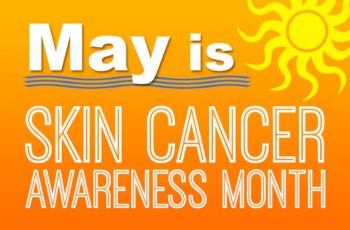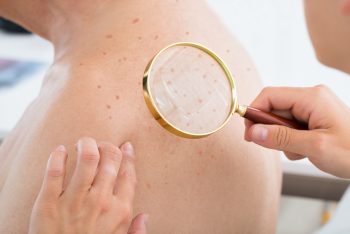 SKIN CANCER – EARLY DETECTION IS KEY
SKIN CANCER – EARLY DETECTION IS KEY
Hi everyone and welcome to our last Factual Friday of the month. While we’re all finding ways to cope with the current “virus crisis”, it’s important we also remember to take care of the additional health issues we face every day. And because May is SKIN CANCER AWARENESS MONTH, we’re going to dedicate today’s blog to the FULL BODY CHECK.
As many of you already know, skin cancer is the most common cancer in the world. There are three types of skin cancer, including basel cell, squamous cell and melanoma, with basel cell being the least serious and melanoma the most serious.
Now, most skin cancers begin as obvious anomalies on our skin. The good news about this is that many potentially dangerous skin cancers can be spotted by the individual her or himself.
But, here’s the thing. We can’t personally inspect our entire body. Most of us can’t see every inch of our scalp or back or inside our ears. Not only that, but skin cancer can develop anywhere on the skin – even in places where the sun has never shined. This is why we all need a professional to give us the once over at least once a year. And, this is what you should expect when you do so.
The first thing of which I want to remind everyone is that a full body check means your full body will be checked. Accordingly, pick a dermatologist with whom you’re comfortable. If you’re a female, you might be more comfortable with a female doctor. If you’re a male, you may want a male doctor.
Once in the examination room, you’ll be asked to remove your clothing – with the typical exception of underwear – and put on a gown. Your doctor will proceed to examine every inch of your body from the top of your head to the soles of your feet. They will check the inside of your mouth, your ears, scalp and hair follicles. They’ll continue with an examination of your arms, back, torso, chest, legs and groin. And they’ll usually finish up with your hands and feet, every finger and toe. 
For most patients, this procedure only takes about twenty minutes. Yet for those of us who have a history of skin cancer like myself, it may take a bit longer. Just be patient and remember that this exam is one of the best tools we have to detect skin cancer early and treat it successfully.
Also, for those who are reluctant to undergo a full body check because of its intimate nature, please remember that your doctor and all these wonderful professionals have performed body checks hundreds, if not thousands, of times. And one naked rear end is just like any other. So, please don’t let unnecessary embarrassment or anxiety get in the way of a potentially life-saving procedure.
Let’s close this discussion now with a few Take-Away Tips that you can use at home between visits with your dermatologist.
Since moles can often become precancerous or cancerous, it’s important to keep an eye on them. Called the ABCD and Es of MOLES, this is what you want to look for when examining a mole on your body.
ASYMMETRY – One half looks different from the other half.
BORDER – An irregular border, poorly defined.
COLOR – A variation in color from one part of the mole to another.
DIAMETER – Melanomas typically are 6 millimeters or greater, but smaller moles must be monitored as well.
EVOLVING – Moles or lesions that change over time and look different from the rest.
 Remember, all human skin is susceptible to cancer. It doesn’t matter what color your skin is. And, cancer can develop anywhere we have skin whether the area has been exposed to the damaging rays of the sun or not.
Remember, all human skin is susceptible to cancer. It doesn’t matter what color your skin is. And, cancer can develop anywhere we have skin whether the area has been exposed to the damaging rays of the sun or not.
So, if you notice a new lump or bump that doesn’t go away, see your dermatologist. If you have a lesion or wound that doesn’t heal, see your dermatologist. If you have a “spot” that appears flaky, rough or red, see your dermatologist. If you have an area of skin that constantly itches, see your dermatologist. And, if you have a mole that changes in appearance, see your dermatologist. And, even if you don’t notice any of these things, make sure you see your dermatologist once a year anyway. The Full Body Check just might save your life!
Thanks again for joining me everyone. Until next time, STAY SAFE, STAY STRONG, stay in GOOD HEALTH and . . .



Leave a Comment